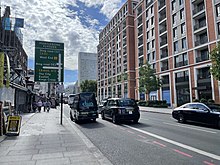
Kilburn is a locality on the boundary of three London Boroughs: Camden, Brent and the City of Westminster. Kilburn High Road railway station lies 3.5 miles (5.6 km) north-west of Charing Cross.

Paddington is an area in the City of Westminster, in central London, England. A medieval parish then a metropolitan borough, it was integrated with Westminster and Greater London in 1965. Paddington station, designed by the engineer Isambard Kingdom Brunel opened in 1847. It is also the site of St Mary's Hospital and the former Paddington Green Police Station.

Marylebone Road is an important thoroughfare in central London, within the City of Westminster. It runs east–west from the Euston Road at Regent's Park to the A40 Westway at Paddington. The road which runs in three lanes in both directions, is part of the London Inner Ring Road and as such forms part of the boundary of the zone within which the London congestion charge applies.

Baker Street is a London Underground station at the junction of Baker Street and the Marylebone Road in the City of Westminster. It is one of the original stations of the Metropolitan Railway (MR), the world's first underground railway, opened on 10 January 1863.

Maida Vale is a London Underground station in Maida Vale in inner north-west London. The station is on the Bakerloo line, between Kilburn Park and Warwick Avenue stations, and is in Travelcard Zone 2.
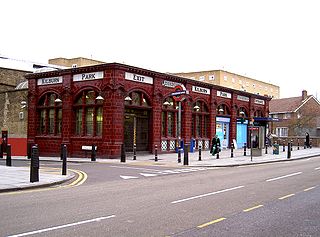
Kilburn Park is a London Underground station at Kilburn in the London Borough of Brent. The station is on the Bakerloo line, between Queen's Park and Maida Vale stations, and is in Travelcard Zone 2.

Edgware Road is a London Underground station on the Circle, District and Hammersmith & City lines, located on the corner of Chapel Street and Cabbell Street, within Travelcard zone 1. A separate station of the same name but served by the Bakerloo line is located about 150 metres away on the opposite side of Marylebone Road.

Brent Cross is a major traffic interchange and area in the London Borough of Barnet, England. Originally the name of a crossroads, it is located a mile from the centres of Hendon and Golders Green. Notably, the Brent Cross Shopping Centre, a major retail facility, was opened in 1976, south of the interchange. The "Brent Cross Flyover" A41 runs to the east of the shopping centre over the A406 North Circular Road, while the M1 motorway and A5 Edgware Road are to the west at Staples Corner interchange. In addition, the Northern line and Thameslink rail routes run on viaducts.

Kilburn High Road railway station is a London Overground station on the London Euston to Watford DC Line near the south end of the Kilburn High Road, London NW6 in the London Borough of Camden.
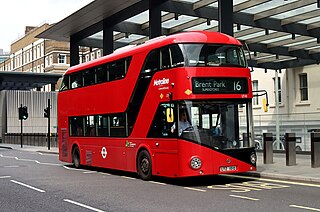
London Buses route 16 is a Transport for London contracted bus route in London, England. Running between Brent Park and Paddington station, it is operated by Metroline.
Stanley A. Heaps (1880–1962) was an English architect responsible for the design of a number of stations on the London Underground system as well as the design of train depots and bus and trolleybus garages for London Transport.
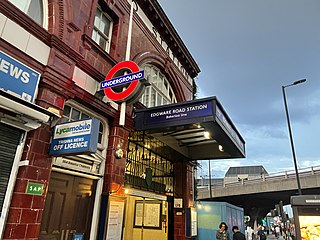
Edgware Road is a London Underground station on the Bakerloo line, located in the City of Westminster. It is between Paddington and Marylebone stations on the line and falls within Travelcard zone 1. The station is located on the north-east corner of the junction of Edgware Road, Harrow Road and Marylebone Road. It is adjacent to the Marylebone flyover.

London Buses route 332 was a Transport for London contracted bus route in London, England. It ran between Brent Park and Paddington station, and was operated by Metroline.

The A40 is a major trunk road connecting London to Fishguard, Wales. The A40 in London starts in the City of London and passes through six London Boroughs: Camden, Westminster, Kensington & Chelsea, Hammersmith & Fulham, Ealing and Hillingdon, to meet the M40 motorway junction 1 at Denham, Buckinghamshire.

The Baker Street and Waterloo Railway (BS&WR), also known as the Bakerloo tube, was a railway company established in 1893 that built a deep-level underground "tube" railway in London. The company struggled to fund the work, and construction did not begin until 1898. In 1900, work was hit by the financial collapse of its parent company, the London & Globe Finance Corporation, through the fraud of Whitaker Wright, its main shareholder. In 1902, the BS&WR became a subsidiary of the Underground Electric Railways Company of London (UERL) controlled by American financier Charles Yerkes. The UERL quickly raised the funds, mainly from foreign investors.

Edgware Road Tube schemes covers a number of proposals to build an underground railway in London, UK at the end of the 19th century. Each scheme envisaged building some form of rail tunnel along the Edgware Road in north-west London towards Victoria railway station.

The London Night Bus network is a series of night bus routes that serve Greater London. Services broadly operate between the hours of 23:00 and 06:00.
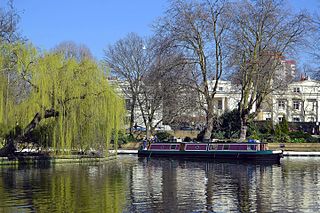
Little Venice is an affluent residential district in West London, England, around the junction of the Paddington Arm of the Grand Union Canal, the Regent's Canal, and the entrance to Paddington Basin. The junction forms a triangular shape basin. Many of the buildings in the vicinity are Regency white painted stucco terraced town houses and taller blocks (mansions) in the same style. The area is 2.5 miles (4.0 km) west-north-west of Charing Cross and immediately north-west of Paddington.

The Royal Commission on London Traffic was a royal commission established in 1903 with a remit to review and report on how transport systems should be developed for London and the surrounding area. It produced a report in eight volumes published in 1905 and made recommendations on the character, administration and routing of traffic in London.
Maida Vale is an electoral ward of the City of Westminster. The population at the 2011 Census was 10,210. The ward covers the area south of Kilburn, north of Little Venice and west of St John's Wood, bordered by Maida Vale (A5), Shirland Road, Sutherland Avenue and Kilburn Park Road. The ward contains Paddington Recreation Ground, Lauderdale Road Spanish & Portuguese Synagogue, Saint Augustine's church and is home to the BBC Maida Vale Studios. The area is served by Maida Vale station on the Bakerloo line, in addition to several bus routes running through the locality. There are two primary schools, Essendine Primary School and St Augustine's Primary School, two secondary schools, St Augustine's CE High School and St. George's Catholic School, in addition to three GP surgeries located in the ward.
